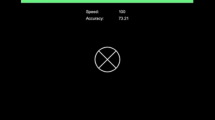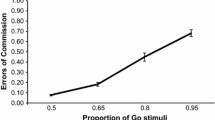Abstract
The Sustained Attention to Response Task (SART) has been widely used in psychological literature as a measure of vigilance (the ability to sustain attention over a prolonged period of time). This task uses a Go/No-Go paradigm and requires the participants to repetitively respond to the stimuli as quickly and as accurately as possible. Previous literature indicates that performance in SART is subjected to a “speed–accuracy trade-off” (SATO) resulting from strategy choices and from the failures of controlling motor reflexes. In this study, 36 participants (n = 36) performed a series of four SARTs. The results support the perspective of strategy choice in SART and suggest that within-subjects SATO in SART should also be acknowledged in attempting to explain SART performance. The implications of the speed–accuracy trade-off should be fully understood when the SART is being used as a measure or tool.



Similar content being viewed by others
References
Alexander RA (1990) A note on averaging correlations. Bull Psychon Soc 28:335–336
Beckmann N, Wood RE (2017) Dynamic personality science. Integrating between-person stability and within person change. Front Psychol 8:1486
Bedi A (2015) The effects of response probability on commission errors in high go low no-go dual response versions of the sustained attention to response task (SART). (Unpublished master’s thesis). University of Canterbury
Berto R (2005) Exposure to restorative environments helps restore attentional capacity. J Environ Psychol 25:249–259
Cheyne JA, Solman GJ, Carriere JS, Smilek D (2009) Anatomy of an error: a bidirectional state model of task engagement/disengagement and attention-related errors. Cognition 111:98–113
Christoff K, Gordon AM, Smallwood J, Smith R, Schooler JW (2009) Experience sampling during fMRI reveals default network and executive system contributions to mind wandering. Proc Natl Acad Sci 106:8719–8724
Cohen J, Cohen P (1983) Applied multiple regression/correlation analysis for the behavioral sciences. Erlbaum, Hillsdale
Dang JS, Figueroa IJ, Helton WS (2017) Determining practice effects on a cognitive flexibility assessment. Proc Hum Factors Ergon Soc Annu Meet 61:1829–1833
Finkbeiner KM, Wilson KM, Russell PN, Helton WS (2014) The effects of warning cues and attention-capturing stimuli on the sustained attention to response task. Exp Brain Res 233:1061–1068
Head J, Helton WS (2013) Perceptual decoupling or motor decoupling? Conscious Cogn 22:913–919
Head J, Helton WS (2016) The troubling science of neurophenomenology. Exp Brain Res 1–5
Head J, Wilson K, Helton WS, Kemp S (2013) The role of calmness in a high-Go target detection task. Proc Hum Factors Ergon Soc Annu Meet 57:838–842 (Sage CA: Los Angeles, CA: SAGE Publications)
Helton WS (2009) Impulsive responding and the sustained attention to response task. J Clin Exp Neuropsychol 31:39–47
Helton WS, Head J, Russell PN (2011) Reliable- and unreliable-warning cues in the sustained attention to response task. Exp Brain Res 209:401–407
Helton WS, Funke GJ, Knott BA (2014) Measuring workload in collaborative contexts: trait versus state perspectives. Hum Factors 56:322–332
Laming DRJ (1968) Information Theory of Choice-Reaction Times. Academic Press, London
Manly T, Robertson IH, Galloway M, Hawkins K (1999) The absent mind: further investigations of sustained attention to response. Neuropsychologia 37:661–670
McAvinue IL, O’Keeffe F, McMackin D, Robertson IH (2005) Impaired sustained attention and error awareness in traumatic brain injury: implications for insight. Neuropsychol Rehabil 15:569–587
Miller J (1991) Reaction time analysis with outlier exclusion: Bias varies with sample size. Q J Exp Psychol A 43:907–912
Molenaar PCM (2004) A manifesto on psychology as idiographic science: bringing the person back into scientific psychology, this time forever. Meas 2:201–218
Peebles D, Bothell D (2004) Modelling performance in the sustained attention to response task. In: Proc ICCM 231 236. Carnegie Mellon University/University of Pittsburgh, Pittsburgh
Robertson IH, Manly T, Andrade J, Baddeley BT, Yiend J (1997) ‘Oops!’: Performance correlates of everyday attentional failures in traumatic brain injured and normal subjects. Neuropsychologia 35:747–758
Schooler JW, Smallwood J, Christoff K, Handy TC, Reichle ED, Sayette MA (2011) Meta-awareness, perceptual decoupling and the wandering mind. Trends Cogn Sci 15:319–326
Seli P (2016) The attention-lapse and motor decoupling accounts of SART performance are not mutually exclusive. Conscious Cogn 41:189–198
Seli P, Jonker TR, Solman GJ, Cheyne JA, Smilek D (2013a) A methodological note on evaluating performance in a sustained-attention-to-response task. Behav Res Methods 45:355–363
Seli P, Jonker TR, Cheyne JA, Smilek D (2013b) Enhancing SART validity by statistically controlling speed accuracy trade-offs. Front Psychol 4:265
Smallwood J (2013) Penetrating the fog of the decoupled mind: the effects of visual salience in the sustained attention to response task. Can J Exp Psychol 67:32–40
Smallwood J, Davies JB, Heim D, Finnigan F, Sudberry M, O’Connor R, Obonsawin M (2004) Subjective experience and the attentional lapse: task engagement and disengagement during sustained attention. Conscious Cogn 13:657–690
Teichner WH, Krebs MJ (1974) Laws of visual choice reaction time. Psychol Rev 81:75–98
Wilson KM, Finkbeiner KM, de Joux NR, Russell PN, Helton WS (2016) Go-stimuli proportion influences response strategy in a sustained attention to response task. Exp Brain Res 234:2989–2998
Wilson M, Joux NR, Finkbeiner KM, Russell PN, Retzler JR, Helton WS (2018) Prolonging the response movement inhibits the feed-forward motor program in the sustained attention to response task. Acta Psychol 183:75–84
Wood CC, Jennings JR (1976) Speed-accuracy tradeoff functions in choice reaction time: experimental designs and computational procedures. Atten Percept Psychophys 19:92–102
Woodworth RS, Schlosberg H (1954) Experimental psychology. Holt, New York
Zelenski JM, Larsen RJ (2000) The distribution of basic emotions in everyday life: a state and trait perspective from experience sampling data. J Res Pers 34:178–197
Author information
Authors and Affiliations
Corresponding author
Ethics declarations
Conflict of interest
The authors listed above declare that there is no conflict of interest.
Rights and permissions
About this article
Cite this article
Dang, J.S., Figueroa, I.J. & Helton, W.S. You are measuring the decision to be fast, not inattention: the Sustained Attention to Response Task does not measure sustained attention. Exp Brain Res 236, 2255–2262 (2018). https://doi.org/10.1007/s00221-018-5291-6
Received:
Accepted:
Published:
Issue Date:
DOI: https://doi.org/10.1007/s00221-018-5291-6




